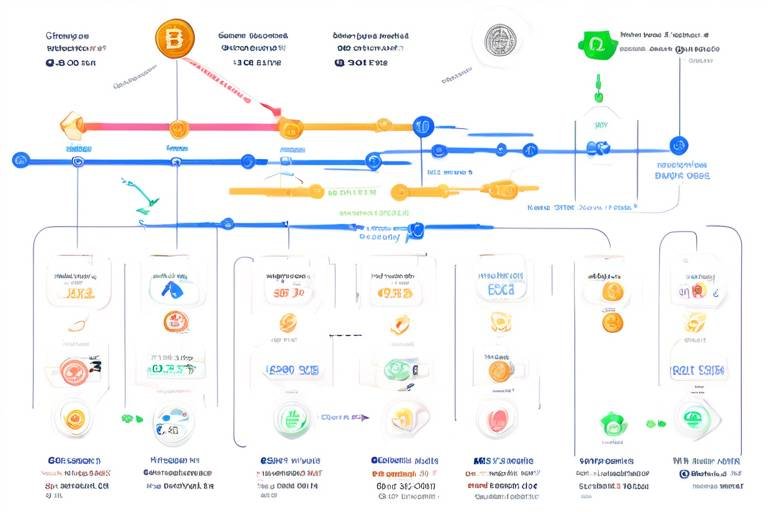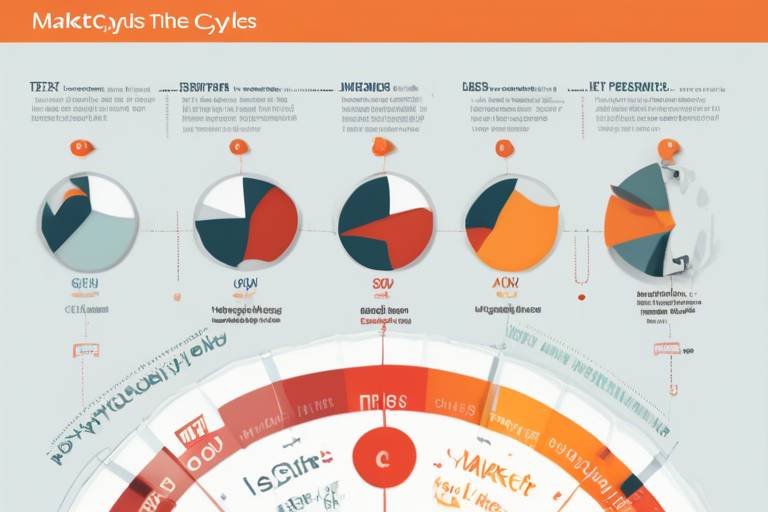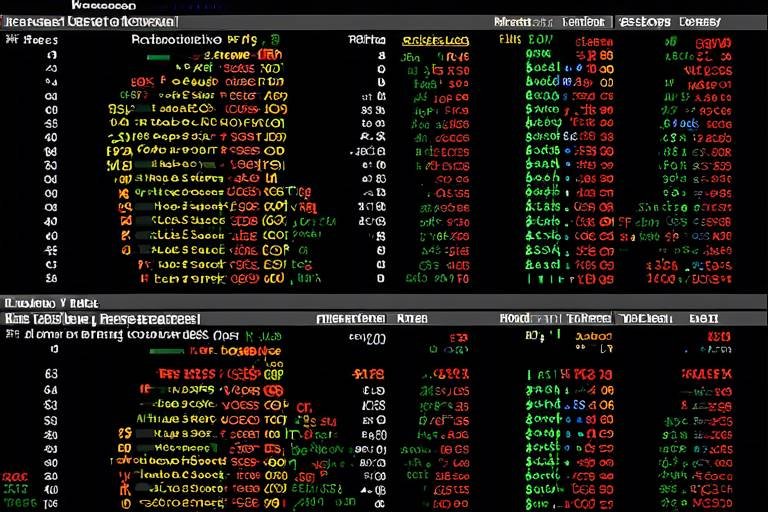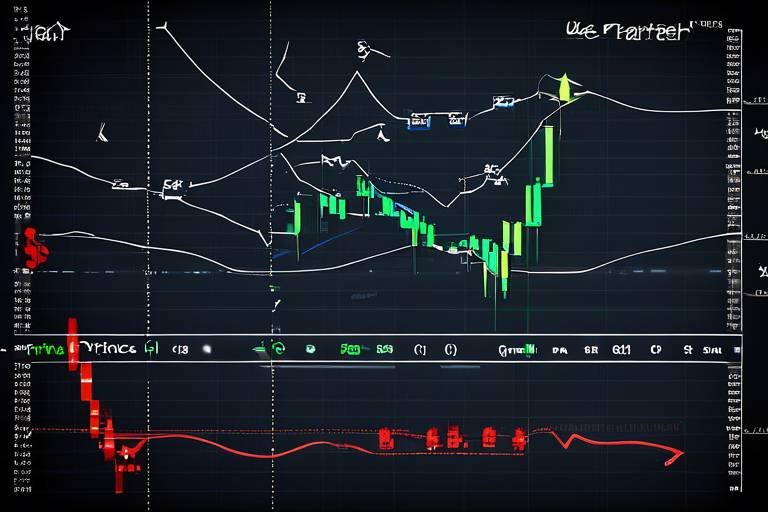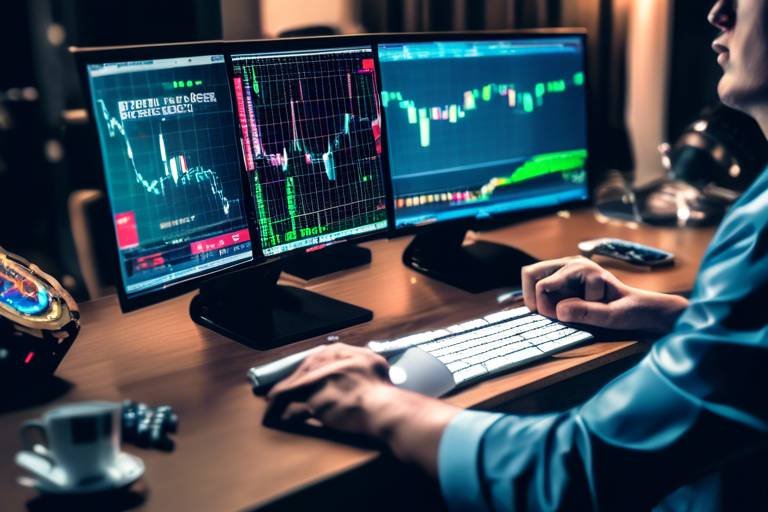Understanding Order Flow in Cryptocurrency Markets
In the ever-evolving world of cryptocurrency trading, understanding order flow is like having a secret weapon in your trading arsenal. Imagine you're at a bustling marketplace where buyers and sellers are constantly negotiating prices. The way these transactions unfold—who's buying, who's selling, and at what price—can tell you a lot about the market's current state and future direction. This article dives deep into the intricacies of order flow, highlighting its significance in trading, the key components that make it up, and effective strategies to analyze it. By the end, you'll have a clearer understanding of how to interpret market behavior and make informed trading decisions.
Order flow analysis is not just a buzzword; it's an essential skill for traders who want to navigate the volatile waters of cryptocurrency markets. It provides insights into market dynamics, helping you grasp the underlying supply and demand that drives price movements. Think of it as reading the pulse of the market—understanding when to enter and exit trades based on real-time information rather than relying solely on historical data or gut feelings. This approach can significantly enhance your trading outcomes and overall profitability.
To truly master order flow, you need to familiarize yourself with its key components. These include market orders, limit orders, and the order book. Each of these elements plays a crucial role in how trades are executed and how prices are determined. By understanding these components, you can better interpret market behavior and make decisions that align with current trends. In the following sections, we'll break down these components and explore how they impact your trading strategies.
So, are you ready to unlock the secrets of order flow in cryptocurrency trading? Let’s dive in and explore how you can leverage this knowledge to enhance your trading game!
Order flow analysis is crucial for traders as it provides insights into market dynamics, helping them understand supply and demand, and ultimately guiding their trading strategies for better outcomes.
Understanding the essential components of order flow, such as market orders, limit orders, and order book dynamics, is vital for traders to interpret market behavior and make informed decisions.
Differentiating between market orders and limit orders is fundamental for traders, as each type affects price movement and liquidity in distinct ways, impacting overall trading strategy and execution.
Market orders can significantly influence price levels by executing trades instantly, often resulting in slippage, which traders must consider when planning their strategies.
Limit orders allow traders to specify the price at which they wish to buy or sell, providing more control over execution but potentially missing out on trades if the market moves quickly.
The order book is a vital tool for traders, displaying real-time buy and sell orders, allowing for a better understanding of market depth, liquidity, and potential price movements.
Effective strategies for analyzing order flow involve using various tools and techniques, such as volume analysis and footprint charts, to gain insights into market sentiment and price action.
Volume profile analysis helps traders identify key price levels where significant trading activity occurs, providing insights into support and resistance areas essential for making informed trading decisions.
Footprint charts offer a detailed view of order flow, displaying volume at specific price levels and allowing traders to assess market sentiment and potential reversals based on buying and selling pressure.
Traders often make mistakes in order flow trading, such as misinterpreting signals or overreacting to short-term fluctuations, which can lead to poor decision-making and losses.
Overtrading based on short-term order flow signals can lead to increased transaction costs and emotional trading, ultimately harming a trader's strategy and overall profitability.
Failing to consider the broader market context can result in misinterpretation of order flow data, leading to misguided trades that do not align with overall market trends or sentiment.
- What is order flow analysis?
Order flow analysis involves studying the buy and sell orders in the market to understand price movements and market dynamics.
- Why is order flow important in cryptocurrency trading?
It helps traders gauge market sentiment, identify potential price levels, and make informed decisions based on real-time data.
- How can I improve my order flow trading skills?
Regular practice, using tools like volume profile analysis and footprint charts, and staying updated with market trends can enhance your skills.

The Importance of Order Flow Analysis
Order flow analysis is more than just a technical tool; it's a window into the market's soul. By diving into the intricacies of order flow, traders can uncover the hidden forces that drive price movements. Imagine standing on the sidelines of a bustling marketplace, where every shout and every transaction tells a story. This is precisely what order flow analysis offers—a narrative about supply and demand that can guide traders in making informed decisions.
Understanding order flow is vital for several reasons:
- Market Dynamics: It provides insights into the underlying dynamics of the market, helping traders gauge whether the market is bullish or bearish.
- Supply and Demand: By analyzing the flow of orders, traders can identify areas of high buying or selling interest, which are crucial for determining potential price reversals.
- Risk Management: Effective order flow analysis aids in setting stop-loss orders and profit targets, as traders can better anticipate price movements based on real-time data.
In the world of cryptocurrency, where volatility reigns supreme, having a grasp on order flow can be the difference between profit and loss. Traders who rely solely on historical price charts may find themselves at a disadvantage, as they miss out on the real-time market sentiment that order flow analysis reveals. Think of it as having a GPS while navigating through a maze; while others may be guessing their way through, you have a clear path laid out before you.
Moreover, order flow analysis fosters a deeper understanding of market psychology. It allows traders to see how others are positioned in the market and what their intentions might be. Are they buying aggressively, or are they waiting for a better price? These insights can significantly enhance a trader's strategy, enabling them to align their trades with the broader market sentiment.
Ultimately, the importance of order flow analysis cannot be overstated. It equips traders with the tools they need to navigate the turbulent waters of cryptocurrency trading with confidence. As they learn to read the flow of orders, they become not just participants in the market but informed strategists capable of making decisions that lead to success.
- What is order flow analysis? Order flow analysis involves studying the flow of buy and sell orders in the market to gain insights into price movements and market sentiment.
- Why is order flow important in cryptocurrency trading? It helps traders understand supply and demand dynamics, manage risk effectively, and make informed trading decisions based on real-time data.
- How can I start analyzing order flow? Traders can utilize tools like order books, volume analysis, and footprint charts to begin their order flow analysis journey.

Key Components of Order Flow
Understanding the is essential for traders who want to navigate the cryptocurrency markets effectively. Order flow analysis is not just about looking at price charts; it involves diving deeper into the mechanics of how orders interact with each other. By grasping the intricacies of these components, traders can gain a significant edge in their trading strategies. The primary components include market orders, limit orders, and the order book dynamics. Each of these plays a critical role in shaping market behavior.
Let’s break it down. First, we have market orders. These are orders to buy or sell a cryptocurrency at the current market price. When a trader places a market order, it gets executed immediately, which can lead to rapid price changes. This is particularly important in the volatile world of cryptocurrencies, where prices can shift dramatically in seconds. Market orders are great for those who want to enter or exit a position quickly, but they come with the risk of slippage, where the execution price may differ from the expected price due to rapid market movements.
On the other hand, there are limit orders. Unlike market orders, limit orders allow traders to specify the price at which they want to buy or sell. This gives traders more control over their trades, but it also comes with its own set of challenges. If the market price never reaches the limit order, the trade will not execute, which means potential opportunities can be missed. However, limit orders can help traders avoid slippage and ensure they enter or exit positions at their desired price points.
Next, let’s talk about the order book. This is where the magic happens. The order book displays all the current buy and sell orders in the market, giving traders a real-time view of market depth and liquidity. By analyzing the order book, traders can identify where significant buying or selling pressure exists. This can help them predict potential price movements and make more informed decisions. Understanding the order book is akin to having a backstage pass to the market, allowing traders to see the real-time dynamics at play.
To summarize, the key components of order flow—market orders, limit orders, and the order book—are fundamental for traders looking to make sense of market movements. Each component interacts with the others, creating a complex web of supply and demand that drives price changes. By mastering these elements, traders can enhance their ability to analyze market behavior and refine their trading strategies for better outcomes.
- What is the difference between market orders and limit orders?
Market orders execute immediately at the current market price, while limit orders allow traders to set a specific price for their trades. - How does the order book affect trading decisions?
The order book provides insights into market depth and liquidity, helping traders gauge buying and selling pressure. - Can slippage be avoided?
Slippage can be minimized by using limit orders rather than market orders, especially in volatile markets.

Market Orders vs. Limit Orders
When diving into the world of cryptocurrency trading, one of the first concepts you’ll encounter is the distinction between market orders and limit orders. Understanding these two types of orders is fundamental for any trader looking to navigate the volatile waters of crypto markets effectively. So, what’s the difference? Let’s break it down!
A market order is a request to buy or sell a cryptocurrency at the best available price in the market. This type of order is executed immediately, which means you’ll get the current market price, but it might not be exactly what you expect. Imagine you’re at a bustling marketplace—if you want to buy apples right now, you’ll grab the first ones you see, regardless of whether they’re the best quality or the lowest price. This is similar to how market orders work. The advantage? Speed! You get in and out of trades quickly, which can be crucial during sudden price movements. However, the downside is the potential for slippage, where the execution price may differ from the expected price, especially in fast-moving markets.
On the other hand, a limit order allows you to set a specific price at which you want to buy or sell a cryptocurrency. This order won’t execute unless the market reaches your desired price. Think of it like placing a bid at an auction; you’re saying, “I’m willing to pay this much, but not a penny more.” This gives you greater control over your trades, allowing you to avoid the pitfalls of slippage. However, there’s a catch—if the market doesn’t reach your limit price, your order won’t be filled, and you could potentially miss out on a trade altogether. It’s a bit like waiting for that perfect moment to buy your favorite gadget; you might miss a great deal if you’re too picky!
To summarize the key differences between market and limit orders, check out the table below:
| Feature | Market Orders | Limit Orders |
|---|---|---|
| Execution Speed | Immediate | Conditional (only at specified price) |
| Price Control | No control (current market price) | Full control (set your price) |
| Risk of Slippage | High | None (unless market moves quickly) |
| Market Impact | Can affect price | Less likely to impact price |
In conclusion, both market and limit orders have their unique advantages and disadvantages. As a trader, it’s essential to understand when to use each type of order based on your trading strategy and market conditions. Whether you prefer the immediacy of market orders or the precision of limit orders, knowing how they work can make a significant difference in your trading success.
- What is a market order? A market order is an order to buy or sell a cryptocurrency at the best available price in the market, executed immediately.
- What is a limit order? A limit order allows a trader to specify a price at which they want to buy or sell a cryptocurrency, executing only when the market reaches that price.
- Which order type is better? It depends on your trading strategy. Market orders are best for quick trades, while limit orders provide price control.
- Can I use both types of orders? Absolutely! Many traders use a combination of both to optimize their strategies.

Impact of Market Orders
Market orders play a crucial role in the cryptocurrency trading landscape, primarily because they are executed immediately at the current market price. This immediacy can lead to significant price movements, especially in a volatile market like cryptocurrency. When a trader places a market order, they are essentially saying, "I want to buy or sell right now, regardless of the price." This can create a ripple effect, influencing prices in ways that traders need to be acutely aware of.
One of the most notable effects of market orders is slippage. Slippage occurs when a market order is executed at a price different from what the trader expected, usually due to rapid price changes. For instance, if you place a market order to buy Bitcoin at $40,000, and the price jumps to $40,100 before your order is filled, you will have experienced slippage. This can be particularly detrimental in fast-moving markets, where every second counts. Traders must account for this phenomenon when planning their strategies, as it can significantly impact profitability.
Moreover, the volume of market orders can affect overall liquidity in the market. When there are a large number of market orders being executed, it can lead to a temporary imbalance between supply and demand, pushing prices in one direction or another. This is especially true in smaller or less liquid markets, where a single large market order can dramatically shift the price. For example, if a trader decides to sell a large quantity of an altcoin using a market order, it may flood the market with sell orders, causing the price to plummet.
In addition to slippage and liquidity concerns, traders must also be aware of the psychological impact of market orders. The immediate execution of these orders can create a sense of urgency, leading traders to make impulsive decisions. This can be likened to a roller coaster ride—once you're on, there's no turning back. The thrill of instant execution can cloud judgment, prompting traders to act on emotions rather than sound analysis.
To summarize, market orders are a double-edged sword in cryptocurrency trading. While they offer the advantage of immediate execution, they also come with risks such as slippage, liquidity issues, and emotional trading. Understanding these impacts is vital for traders who wish to navigate the tumultuous waters of the crypto markets effectively.
- What is the difference between a market order and a limit order? A market order is executed immediately at the current market price, while a limit order specifies a price at which the trader wants to buy or sell.
- How does slippage affect my trades? Slippage can lead to executing trades at prices different from what you expected, which may reduce your potential profits or increase losses.
- Can market orders impact the overall market? Yes, large market orders can create significant price movements and affect market liquidity, especially in less liquid markets.

Limit Orders and Their Role
Limit orders play a crucial role in the cryptocurrency trading landscape, offering traders a way to maintain control over their transactions. Unlike market orders, which execute immediately at the best available price, limit orders allow traders to set a specific price at which they are willing to buy or sell an asset. This can be particularly advantageous in a volatile market, where prices can fluctuate dramatically in a matter of seconds. By using limit orders, traders can avoid the pitfalls of slippage—a scenario where the execution price differs from the expected price due to rapid market movements.
Imagine you're at a bustling auction, and you're eyeing a rare collectible. You want to ensure you don't overpay, so you set a maximum bid. This is akin to placing a limit order; you specify the price you’re willing to pay, and if the auctioneer (or in this case, the market) doesn’t meet that price, you walk away. This strategy not only protects your capital but also allows you to capitalize on potential price reversals. However, it’s essential to understand that while limit orders provide control, they come with their own set of challenges.
For instance, if the market price moves away from your limit order, you might miss out on a trading opportunity altogether. This can be frustrating, especially in fast-moving markets where every second counts. Additionally, traders must consider the overall market liquidity. In a thinly traded market, limit orders may sit unfilled for extended periods, which can lead to missed opportunities or delayed entries and exits.
To illustrate the impact of limit orders, let’s consider a simple example:
| Order Type | Execution Price | Market Condition |
|---|---|---|
| Market Order | $100 | Executed immediately at the best price |
| Limit Order | $95 | Executed only if the price reaches $95 |
In this table, you can see how a market order guarantees immediate execution but may result in a higher purchase price, while a limit order allows for a lower entry point but carries the risk of not being executed at all. This balance between control and opportunity is what makes limit orders a fundamental tool for any trader.
In conclusion, limit orders are not just a safety net; they are a strategic tool that can enhance a trader's ability to navigate the unpredictable waters of cryptocurrency trading. By understanding how to effectively utilize limit orders, traders can make more informed decisions, aligning their entries and exits with their overall trading strategies. However, it’s vital to remain aware of the market dynamics and be prepared to adjust your strategies as conditions change.
- What is a limit order? A limit order is a type of order to buy or sell a cryptocurrency at a specified price or better.
- When should I use a limit order? Use a limit order when you want to control the price at which you buy or sell, especially in volatile markets.
- What are the risks of using limit orders? The primary risk is that your order may not be filled if the market price does not reach your specified limit.
- Can I cancel a limit order? Yes, you can cancel a limit order at any time before it is executed, depending on the platform you are using.

Understanding the Order Book
The order book is like the heartbeat of the cryptocurrency market. It’s a live, dynamic ledger that shows all the buy and sell orders for a particular asset at any given moment. Think of it as a bustling marketplace where traders are constantly negotiating prices, and the order book captures every transaction in real-time. Understanding this tool is essential for any trader looking to navigate the often turbulent waters of cryptocurrency trading.
At its core, the order book consists of two main components: the bid and ask sides. The bid side represents all the buy orders, indicating how much traders are willing to pay for an asset, while the ask side shows the sell orders, revealing the lowest price at which sellers are willing to part with their assets. This relationship between buyers and sellers creates a fascinating dance of supply and demand that can significantly influence price movements.
To further illustrate this, let’s consider a simple table that outlines how the order book might look for a hypothetical cryptocurrency:
| Price (USD) | Bid Volume | Ask Volume |
|---|---|---|
| 50.00 | 10 BTC | 5 BTC |
| 49.50 | 15 BTC | 8 BTC |
| 49.00 | 20 BTC | 12 BTC |
| 48.50 | 5 BTC | 20 BTC |
This table shows various price levels along with the corresponding bid and ask volumes. As you can see, at a price of $50.00, there are 10 BTC available to buy, while sellers are only willing to sell 5 BTC at that price. This imbalance can create upward pressure on the price as buyers outnumber sellers. Conversely, it can also indicate potential resistance if sell orders at higher prices are substantial enough to absorb buying pressure.
Traders can leverage the order book to gauge market sentiment. For instance, if the bid volume is significantly higher than the ask volume, it may suggest bullish sentiment, indicating that buyers are eager to enter the market. On the flip side, if the ask volume dominates, it could imply a bearish sentiment, where sellers are more inclined to offload their assets. However, it’s crucial to remember that the order book is not static; it constantly changes as new orders come in and existing ones are filled or canceled.
Moreover, understanding the concept of market depth is pivotal. Market depth refers to the ability of the market to sustain relatively large market orders without impacting the price of the asset significantly. A deeper market, with numerous buy and sell orders at various price levels, indicates higher liquidity, making it easier for traders to execute large transactions without causing drastic price fluctuations. In contrast, a shallow market can lead to volatility, as even small orders can lead to significant price changes.
In conclusion, the order book is an invaluable resource for cryptocurrency traders. By analyzing the bid and ask volumes, as well as market depth, traders can gain insights into market trends, potential price movements, and overall sentiment. This understanding allows them to make more informed decisions, enhancing their trading strategies and potentially leading to better outcomes in the fast-paced world of cryptocurrency trading.
- What is the order book?
The order book is a real-time list of buy and sell orders for a particular cryptocurrency, showing the prices and volumes available for trading.
- How can I use the order book in trading?
By analyzing the bid and ask volumes, traders can gauge market sentiment and make informed decisions about entering or exiting trades.
- What does market depth mean?
Market depth indicates how much buying or selling can occur without significantly affecting the price of the asset, reflecting the liquidity of the market.

Strategies for Analyzing Order Flow
When it comes to navigating the tumultuous waters of cryptocurrency trading, having a solid strategy for analyzing order flow can be your lifeboat. It's not just about buying low and selling high anymore; understanding the intricate dance of orders can give you a significant edge. So, how do you tap into this powerful tool? Here are some effective strategies that can elevate your trading game.
First off, volume analysis is a cornerstone of order flow analysis. By examining the volume of trades at different price levels, traders can identify where the action is happening. For instance, if you notice a spike in volume at a particular price point, it could indicate a strong support or resistance level. This is essential because it helps you gauge market sentiment. Are traders bullish or bearish? The volume can often tell you before the price moves significantly.
Another powerful tool in your arsenal is the footprint chart. This chart provides a granular view of order flow by breaking down the volume at each price level, revealing whether buyers or sellers are in control. Imagine walking into a room and immediately sensing whether the mood is tense or relaxed; that’s what footprint charts do for traders. They help you assess the buying and selling pressure in real-time, making it easier to anticipate market reversals or continuations.
To make the most of these tools, consider implementing a multi-faceted approach. For example, you could use volume profile analysis in conjunction with footprint charts. This combination allows you to pinpoint key price levels while simultaneously understanding the market sentiment behind those levels. It’s like having a map and a compass; you can see where you are and where you’re headed.
But wait, there's more! Don’t overlook the importance of contextual analysis. This means looking at the broader market conditions while analyzing order flow. Are there any significant news events on the horizon? What are the trends in other cryptocurrencies? Ignoring these factors can lead to misguided trades. For instance, if you see bullish order flow but the overall market is bearish due to negative news, it might be wise to tread carefully.
Finally, keep an eye on the order book. It's like a live feed of the market's heartbeat, showing you real-time buy and sell orders. By observing changes in the order book, you can gain insights into potential price movements. For example, if you notice a large sell order getting filled, it might signal a shift in market sentiment. This kind of information can be invaluable for making timely decisions.
In summary, mastering order flow analysis requires a blend of strategies that include volume analysis, footprint charts, contextual awareness, and real-time order book observation. By employing these techniques, you can better navigate the unpredictable world of cryptocurrency trading, turning potential chaos into calculated decisions.
- What is order flow analysis? - Order flow analysis involves studying the buy and sell orders in the market to understand supply and demand dynamics.
- How can volume analysis improve my trading? - Volume analysis helps identify significant price levels where trading activity occurs, providing insights into market sentiment.
- What are footprint charts? - Footprint charts display volume at specific price levels and offer a detailed view of market sentiment and potential reversals.
- Why is market context important? - Understanding the broader market context helps avoid misguided trades that don't align with overall trends.

Volume Profile Analysis
When it comes to trading in the cryptocurrency markets, understanding can be a game changer. This technique helps traders identify where significant trading activity occurs at various price levels, providing invaluable insights into market dynamics. Imagine walking into a bustling marketplace; the areas where the most transactions happen are akin to the price levels with the highest volume in trading. These areas often serve as critical points of support and resistance, which are essential for making informed trading decisions.
Volume profile analysis is not just about looking at numbers; it's about understanding the story behind those numbers. It allows traders to visualize the distribution of volume over a specific time frame, giving them a clearer picture of where buyers and sellers are most active. This understanding can help traders anticipate potential price movements and reversals. For example, if a trader notices a significant volume spike at a particular price level, they might conclude that this level could act as a strong support or resistance zone. This insight can be crucial for setting stop-loss orders or taking profit targets.
To effectively utilize volume profile analysis, traders often look at the following key aspects:
- Value Area: This is the price range where a substantial amount of trading volume occurs. It indicates where the majority of trades are being executed and can serve as a benchmark for future price movements.
- Point of Control (POC): The POC is the price level with the highest trading volume during the selected time frame. This level often acts as a magnet for price action, drawing prices back towards it.
- High and Low Volume Nodes: High volume nodes indicate strong interest in buying or selling at certain price levels, while low volume nodes can signify areas of potential price volatility.
Incorporating volume profile analysis into your trading strategy can be incredibly beneficial. It not only enhances your ability to make informed decisions but also helps you avoid common pitfalls associated with trading based solely on price action. By understanding where the market has historically seen significant activity, you can better position yourself for future trades.
As you delve deeper into volume profile analysis, consider using tools and platforms that offer advanced charting capabilities. Many trading platforms provide built-in volume profile indicators, allowing you to visualize this data seamlessly. Additionally, combining volume profile analysis with other technical indicators can further enhance your trading strategy, giving you a more robust framework for analyzing market conditions.
Q: What is volume profile analysis?
A: Volume profile analysis is a trading technique that displays the amount of trading activity at various price levels over a specified time period, helping traders identify key support and resistance levels.
Q: How can volume profile analysis improve my trading?
A: By understanding where significant trading activity occurs, traders can make more informed decisions, anticipate potential price movements, and set better entry and exit points.
Q: Can I use volume profile analysis with other indicators?
A: Absolutely! Combining volume profile analysis with other technical indicators can provide a more comprehensive view of market conditions, enhancing your overall trading strategy.
Q: Is volume profile analysis suitable for all trading styles?
A: Yes, volume profile analysis can be beneficial for various trading styles, including day trading, swing trading, and long-term investing, as it helps in understanding market dynamics across different time frames.

Footprint Charts Explained
Footprint charts are a powerful tool for traders looking to dive deep into the intricacies of order flow. Unlike traditional charts that merely display price movements over time, footprint charts provide a more granular view by showing the volume of trades at specific price levels. This detailed representation allows traders to assess the underlying market sentiment, revealing whether buyers or sellers are in control at any given moment. Imagine walking through a bustling marketplace; footprint charts are like the signs that tell you where the most activity is happening, helping you navigate the noise and make informed decisions.
At the heart of footprint charts is the concept of volume analysis. Each footprint represents a specific price level and includes information about the volume traded at that price, the number of buyers and sellers, and the net buying or selling pressure. This data can be visually represented in a grid format, where each cell corresponds to a price level, making it easier for traders to spot significant buying or selling activity. For example, if a particular price level shows a high volume of trades with more buying than selling, it may indicate strong support, while the opposite could signal resistance.
To illustrate how footprint charts work, consider the following table:
| Price Level | Buy Volume | Sell Volume | Net Volume |
|---|---|---|---|
| $50,000 | 200 | 100 | +100 |
| $51,000 | 150 | 200 | -50 |
| $52,000 | 300 | 150 | +150 |
In the table above, we can see how the net volume changes at different price levels. The positive net volume at $50,000 suggests that buyers are more aggressive, while the negative net volume at $51,000 indicates selling pressure. Such insights allow traders to make quick decisions based on the real-time dynamics of the market.
Another critical aspect of footprint charts is the ability to identify potential reversals. By analyzing the buying and selling pressure, traders can spot divergences that may indicate a shift in market sentiment. For instance, if prices are rising but the buying volume is decreasing, it could be a sign that the upward momentum is weakening, and a reversal might be on the horizon. This is where the art of trading comes into play—understanding not just the numbers, but what they represent in the broader context of market psychology.
In summary, footprint charts offer traders a unique lens through which to view order flow, enabling them to make more informed decisions based on actual market activity. By combining this tool with other analytical methods, traders can enhance their strategies, improve their timing, and ultimately increase their chances of success in the fast-paced world of cryptocurrency trading.
- What are footprint charts? Footprint charts are advanced trading tools that display the volume of trades at specific price levels, helping traders understand market sentiment.
- How do footprint charts differ from traditional charts? Unlike traditional charts that focus solely on price movements, footprint charts provide insights into the volume of buying and selling activity at each price level.
- Can footprint charts help in identifying reversals? Yes, by analyzing buying and selling pressure, traders can spot divergences that may indicate potential market reversals.
- Are footprint charts suitable for all traders? While footprint charts are valuable for many traders, they are particularly beneficial for those who focus on short-term trading and require detailed market analysis.

Common Mistakes in Order Flow Trading
In the fast-paced world of cryptocurrency trading, understanding order flow is essential, but many traders stumble into common pitfalls that can derail their strategies. One major mistake is overtrading based on short-term signals. It's easy to get caught up in the excitement of rapid price movements and react impulsively to every tiny fluctuation in order flow. This often results in increased transaction costs and emotional trading, which can severely impact profitability. Instead of chasing every signal, traders should focus on a more strategic approach, filtering out noise and concentrating on significant trends that align with their overall trading plan.
Another prevalent error is ignoring market context. Order flow data doesn't exist in a vacuum; it's crucial to consider the broader market conditions and sentiment. For instance, a spike in buying activity might seem promising, but if it occurs during a bearish trend, it could be a false signal. Traders should always analyze order flow in conjunction with other market indicators to avoid misguided trades. By understanding the market context, traders can better interpret the signals provided by the order flow and make more informed decisions.
Furthermore, many traders fail to adequately understand the nuances of market orders versus limit orders. Market orders are executed immediately at the best available price, which can lead to slippage if the market is volatile. In contrast, limit orders allow traders to set their desired price, but they come with the risk of missing out on trades if the market moves too quickly. Mismanaging these orders can lead to unintended consequences, so it’s vital to have a clear strategy in place that considers both types of orders.
Additionally, traders often underestimate the importance of psychological factors in trading. The fear of missing out (FOMO) can drive traders to make hasty decisions that aren't backed by solid analysis. It’s essential to maintain discipline and stick to your trading plan, even when emotions run high. Keeping a trading journal can help in this regard, allowing traders to reflect on their decisions and learn from past mistakes.
To summarize, here are some of the common mistakes to avoid in order flow trading:
- Overtrading based on short-term signals
- Ignoring the broader market context
- Misunderstanding market and limit orders
- Letting emotions dictate trading decisions
By being aware of these pitfalls and taking a more measured approach, traders can enhance their understanding of order flow and improve their overall trading performance.
Q: What is order flow in cryptocurrency trading?
A: Order flow refers to the buying and selling activity in the market, which provides insights into supply and demand dynamics. Understanding order flow helps traders make informed decisions about market trends.
Q: How can I analyze order flow effectively?
A: Effective order flow analysis involves using tools like volume profile analysis, footprint charts, and keeping an eye on the order book to understand market sentiment and price action.
Q: What are the risks of using market orders?
A: Market orders execute trades immediately at the current market price, which can lead to slippage, especially in volatile markets. It's important to weigh the benefits against the potential risks when choosing this type of order.
Q: Why is market context important in order flow trading?
A: Market context provides essential background information that can influence order flow signals. Without considering the broader market conditions, traders may misinterpret data and make poor trading decisions.

Overtrading on Short-Term Signals
Overtrading on short-term signals can be a slippery slope for many traders, especially in the fast-paced world of cryptocurrency. It’s like trying to catch a wave; if you jump in too soon or too late, you might wipe out instead of riding it to shore. Traders often find themselves reacting impulsively to fleeting market movements, thinking they are capitalizing on opportunities. However, this approach can lead to increased transaction costs and emotional turmoil, ultimately harming their trading strategy.
When traders focus too much on short-term signals, they may overlook the bigger picture. This myopic view can result in a series of trades that seem promising but are, in reality, based on noise rather than solid market fundamentals. For instance, a trader might notice a sudden spike in buying activity and rush to enter a position, only to find that the momentum fizzles out as quickly as it began. This can lead to a cycle of buying high and selling low, a surefire way to erode capital.
Moreover, overtrading can lead to increased transaction costs. Each trade incurs fees, and frequent trading can quickly add up, eating into profits. Imagine trying to fill a bucket with water while constantly poking holes in it; no matter how much you pour in, it’s never going to fill up. In trading, the more you overtrade, the less you retain. This is why it's crucial to have a well-defined trading plan that prioritizes quality over quantity.
It’s also essential to consider the emotional aspect of trading. The adrenaline rush from making quick trades can cloud judgment, leading to decisions driven by fear or greed rather than analysis. Traders might find themselves in a cycle of emotional trading, where they feel compelled to act on every signal, regardless of its validity. This can cause significant stress and lead to burnout, making it even harder to make rational decisions in the future.
To mitigate the risks of overtrading, traders should consider implementing the following strategies:
- Set Clear Criteria: Define specific conditions under which you will enter and exit trades. This helps in filtering out noise and focusing on high-probability setups.
- Limit Trade Frequency: Establish a maximum number of trades per day or week to avoid excessive trading. This encourages thoughtful decision-making rather than impulsive reactions.
- Review Performance: Regularly analyze your trades to understand what works and what doesn’t. This reflection can help refine your strategy and reduce the tendency to overtrade.
In conclusion, while short-term signals can provide valuable insights, overtrading based on them can lead to detrimental outcomes. By maintaining a balanced approach and focusing on long-term success, traders can navigate the volatile waters of cryptocurrency markets more effectively.
1. What is overtrading?
Overtrading occurs when a trader executes too many trades in a short period, often in response to short-term market signals, leading to increased costs and emotional stress.
2. How can I avoid overtrading?
To avoid overtrading, set clear trading criteria, limit the number of trades you make, and regularly review your trading performance to refine your strategy.
3. What are the risks of overtrading?
The risks of overtrading include increased transaction costs, emotional trading, and the potential for significant financial losses due to impulsive decisions.

Ignoring Market Context
When diving into the world of cryptocurrency trading, it's easy to get caught up in the minute details of order flow. Traders often focus intently on the data in front of them—like the latest price movements or the volume of trades—without taking a step back to consider the broader market context. This oversight can lead to misguided decisions that might seem logical at first glance but ultimately result in losses. Just like trying to navigate through a dense forest without considering the landscape, ignoring the market context can leave traders lost and vulnerable to unexpected changes.
Understanding the overall market sentiment is crucial. For instance, if a trader notices a surge in buy orders for a particular cryptocurrency but fails to recognize that the entire market is in a downtrend, they might misinterpret this activity as a bullish signal. In reality, it could just be a brief spike in interest before the price continues to fall. To avoid such pitfalls, traders should consider several factors:
- Market Trends: Analyzing whether the market is in a bullish or bearish phase can provide clarity on how to interpret order flow.
- News Events: Major news, such as regulatory changes or technological advancements, can drastically shift market sentiment and should be factored into trading decisions.
- Correlation with Other Assets: Understanding how different cryptocurrencies relate to one another can help in predicting price movements based on order flow.
Additionally, a trader might benefit from keeping an eye on key economic indicators and global events that could impact the cryptocurrency market. For example, interest rate changes in major economies or geopolitical tensions can influence investor behavior, leading to shifts in order flow that may not be immediately apparent from the order book alone. Thus, failing to incorporate these elements into your analysis can result in missed opportunities or, worse, significant losses.
To help illustrate this point, consider a scenario where a trader notices an influx of limit orders at a specific price level. Without knowing that a major announcement is scheduled that could affect the entire market, the trader might impulsively decide to place a market order, thinking they are capitalizing on a favorable condition. However, if the announcement turns out to be negative, the price could plummet, resulting in a loss. Hence, it's essential to maintain a holistic view of the market rather than focusing solely on isolated order flow signals.
In conclusion, while order flow analysis is a powerful tool for traders, it should never be used in a vacuum. By taking the time to understand the market context, traders can make more informed decisions that align with the overall sentiment and trends, ultimately enhancing their trading strategies and improving their chances of success.
- What is order flow analysis? Order flow analysis involves examining the buy and sell orders in the market to understand supply and demand dynamics, helping traders make informed decisions.
- How can I incorporate market context into my trading? Stay updated on market news, trends, and economic indicators that may impact cryptocurrency prices and sentiment.
- Why is it important to differentiate between market and limit orders? Understanding the differences helps traders anticipate price movements and manage their strategies effectively.
- What tools can I use for order flow analysis? Tools such as volume profile analysis and footprint charts can provide valuable insights into market behavior.
Frequently Asked Questions
- What is order flow analysis in cryptocurrency trading?
Order flow analysis refers to the examination of the buying and selling orders in the market. It helps traders understand the dynamics of supply and demand, enabling them to make informed trading decisions based on real-time market behavior.
- Why is order flow important for traders?
Order flow is crucial because it provides insights into market sentiment and potential price movements. By analyzing order flow, traders can identify trends, support and resistance levels, and ultimately enhance their trading strategies for better outcomes.
- What are market orders and limit orders?
Market orders are executed immediately at the current market price, while limit orders allow traders to set a specific price at which they want to buy or sell. Understanding the difference is essential, as it affects how trades are executed and the overall trading strategy.
- How do market orders impact price levels?
Market orders can significantly influence price levels because they are executed instantly. This can lead to slippage, where the execution price differs from the expected price, especially in volatile markets. Traders need to consider this when planning their trades.
- What is an order book and why is it important?
The order book is a real-time ledger that displays all buy and sell orders in the market. It is vital for traders as it provides insights into market depth and liquidity, helping them gauge potential price movements and make informed trading decisions.
- What strategies can I use for analyzing order flow?
Effective strategies include volume profile analysis and using footprint charts. Volume profile helps identify key price levels with significant trading activity, while footprint charts provide a detailed view of order flow, showing volume at specific price levels to assess market sentiment.
- What are common mistakes traders make in order flow trading?
Common mistakes include overtrading based on short-term signals and ignoring the broader market context. These can lead to poor decision-making and losses, as traders may react impulsively to fluctuations without considering overall market trends.
- How can I avoid overtrading?
To avoid overtrading, it's important to stick to a well-defined trading plan, set clear entry and exit points, and avoid making impulsive decisions based on short-term order flow signals. Staying disciplined and patient is key to successful trading.

